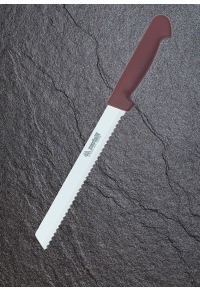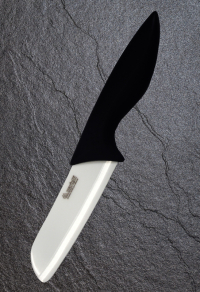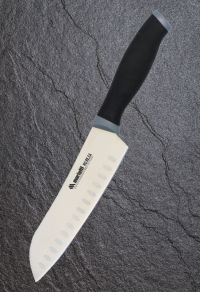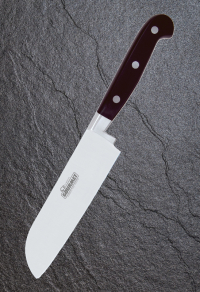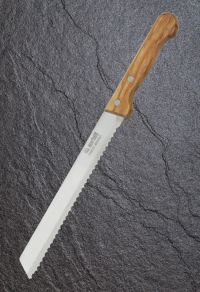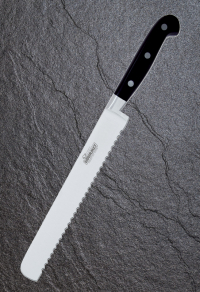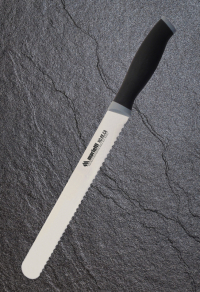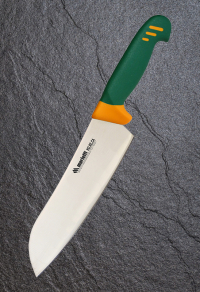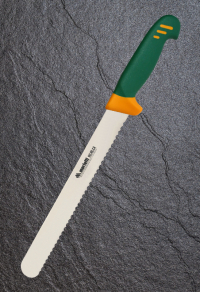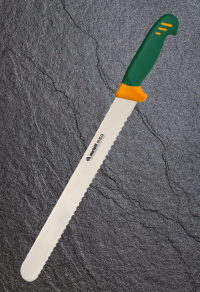Products
Subcategories
-
copy of Knife PANE - cod....
Slicing bread precisely and serving beautiful slices is a daily action. In addition, cakes, casseroles, roulades and other savory or cheesy preparations require a precise cut without having to pressurize the food, and this blade facilitates cutting.The tip is not needed and the blade must be wavy so as to incise the crust slowly without breaking it.
-
Knife SANTOKU - cod. 134CZ
The Santoku knife represents the Japanese equivalent of the European chef's knife (CHEF KNIFE). Characteristic Japanese knife used to cut and chop vegetables. For this operation - in fact - Western cooks use the knife called CHEF KNIFE The big difference between the two blades is that the carving knife is designed so that the tip always remains in contact with the cutting board, while the Santoku is used as a small cleaver and the tip always comes off the cutting board. -
Knife SANTOKU 1235TP
A Santoku has a blade quite similar to a carving knife and is the Japanese equivalent of a chef's knife. Since it is a good idea to have a knife (and a cutting board) for raw food and a knife (and a cutting board) for cooked foods, the second carving knife can be a Santoku so you have the chance to try this type of blade too. The big difference between the two blades is that the carving knife is designed so that the tip always remains in contact with the cutting board, while the Santoku is used as a small cleaver and the tip always comes off the cutting board.
-
Knife SANTOKU - cod. 2016
The Santoku knife represents the Japanese equivalent of the European chef's knife (CHEF KNIFE). Characteristic Japanese knife used to cut and chop vegetables. For this operation - in fact - Western cooks use the knife called CHEF KNIFE The big difference between the two blades is that the carving knife is designed so that the tip always remains in contact with the cutting board, while the Santoku is used as a small cleaver and the tip always comes off the cutting board.
-
Knife PANE
Slicing bread precisely and serving beautiful slices is a daily action. In addition, cakes, casseroles, roulades and other savory or cheesy preparations require a precise cut without having to pressurize the food, and this blade facilitates cutting.The tip is not needed and the blade must be wavy so as to incise the crust slowly without breaking it. -
Knife PANE 1243TP
Slicing bread precisely and serving beautiful slices is a daily action. In addition, cakes, casseroles, roulades and other savory or cheesy preparations require a precise cut without having to pressurize the food, and this blade facilitates cutting.The tip is not needed and the blade must be wavy so as to incise the crust slowly without breaking it.
-
Knife PANE - cod. 2012
Slicing bread precisely and serving beautiful slices is a daily action. In addition, cakes, casseroles, roulades and other savory or cheesy preparations require a precise cut without having to pressurize the food, and this blade facilitates cutting.The tip is not needed and the blade must be wavy so as to incise the crust slowly without breaking it. -
Knife PANE 1244TP
Slicing bread precisely and serving beautiful slices is a daily action. In addition, cakes, casseroles, roulades and other savory or cheesy preparations require a precise cut without having to pressurize the food, and this blade facilitates cutting.The tip is not needed and the blade must be wavy so as to incise the crust slowly without breaking it.
-
Knife SANTOKU 18 STK18
The Santoku knife represents the Japanese equivalent of the European chef's knife (CHEF KNIFE). Characteristic Japanese knife used to cut and chop vegetables. For this operation - in fact - Western cooks use the knife called CHEF KNIFE The big difference between the two blades is that the carving knife is designed so that the tip always remains in contact with the cutting board, while the Santoku is used as a small cleaver and the tip always comes off the cutting board.
-
Knife PANE - cod. 143A
Slicing bread precisely and serving beautiful slices is a daily action. In addition, cakes, casseroles, roulades and other savory or cheesy preparations require a precise cut without having to pressurize the food, and this blade facilitates cutting.The tip is not needed and the blade must be wavy so as to incise the crust slowly without breaking it. -
Knife PANE 24 BRD24
Slicing bread precisely and serving beautiful slices is a daily action. In addition, cakes, casseroles, roulades and other savory or cheesy preparations require a precise cut without having to pressurize the food, and this blade facilitates cutting.The tip is not needed and the blade must be wavy so as to incise the crust slowly without breaking it. -
Knife PANE 31 BRD31
Slicing bread precisely and serving beautiful slices is a daily action. In addition, cakes, casseroles, roulades and other savory or cheesy preparations require a precise cut without having to pressurize the food, and this blade facilitates cutting.The tip is not needed and the blade must be wavy so as to incise the crust slowly without breaking it.








